Gemini Robotics-ER 1.5, विज़न-लैंग्वेज मॉडल (वीएलएम) है. यह Gemini की एजेंटिक क्षमताओं को रोबोटिक्स में इस्तेमाल करने की सुविधा देता है. इसे असल दुनिया में बेहतर तरीके से सोचने-समझने के लिए डिज़ाइन किया गया है. इससे रोबोट, मुश्किल विज़ुअल डेटा को समझ पाते हैं, जगह के हिसाब से सोच-विचार कर पाते हैं, और नैचुरल लैंग्वेज में दिए गए निर्देशों के हिसाब से काम कर पाते हैं.
मुख्य सुविधाएं और फ़ायदे:
- बेहतर स्वायत्तता: रोबोट, ओपन-एंडेड एनवायरमेंट में बदलावों के हिसाब से काम कर सकते हैं, उनमें बदलाव कर सकते हैं, और उनके हिसाब से जवाब दे सकते हैं.
- नैचुरल लैंग्वेज में बातचीत करने की सुविधा: इससे रोबोट का इस्तेमाल करना आसान हो जाता है. साथ ही, नैचुरल लैंग्वेज का इस्तेमाल करके मुश्किल टास्क असाइन किए जा सकते हैं.
- टास्क ऑर्केस्ट्रेशन: यह सुविधा, नैचुरल लैंग्वेज में दिए गए निर्देशों को सबटास्क में बांटती है. साथ ही, लंबे समय तक चलने वाले टास्क को पूरा करने के लिए, मौजूदा रोबोट कंट्रोलर और व्यवहारों के साथ इंटिग्रेट करती है.
- कई तरह की सुविधाएं: यह ऑब्जेक्ट का पता लगाता है और उनकी पहचान करता है. साथ ही, ऑब्जेक्ट के बीच के संबंध को समझता है, उन्हें पकड़ने और उनकी दिशा तय करने की योजना बनाता है, और डाइनैमिक सीन को समझता है.
इस दस्तावेज़ में बताया गया है कि मॉडल क्या करता है. साथ ही, इसमें कई उदाहरण दिए गए हैं, जिनसे मॉडल की एजेंट के तौर पर काम करने की क्षमताओं के बारे में पता चलता है.
अगर आपको तुरंत इस मॉडल का इस्तेमाल शुरू करना है, तो Google AI Studio में जाकर इसे आज़माएं.
सुरक्षा
Gemini Robotics-ER 1.5 को सुरक्षा को ध्यान में रखकर बनाया गया है. हालांकि, रोबोट के आस-पास सुरक्षित माहौल बनाए रखना आपकी ज़िम्मेदारी है. जनरेटिव एआई मॉडल से गलतियां हो सकती हैं. साथ ही, फ़िज़िकल रोबोट से नुकसान हो सकता है. सुरक्षा हमारी प्राथमिकता है. साथ ही, असल दुनिया के रोबोटिक्स के साथ जनरेटिव एआई मॉडल का इस्तेमाल करते समय, उन्हें सुरक्षित बनाना हमारी रिसर्च का एक अहम हिस्सा है. ज़्यादा जानने के लिए, Google DeepMind के रोबोटिक्स की सुरक्षा से जुड़ा पेज पर जाएं.
शुरू करना: किसी सीन में ऑब्जेक्ट ढूंढना
इस उदाहरण में, रोबोटिक्स के इस्तेमाल का एक सामान्य उदाहरण दिखाया गया है. इसमें, generateContent तरीके का इस्तेमाल करके, मॉडल को इमेज और टेक्स्ट प्रॉम्प्ट पास करने का तरीका बताया गया है. इससे, पहचाने गए ऑब्जेक्ट की सूची और उनके 2D पॉइंट मिलते हैं.
मॉडल, इमेज में पहचाने गए आइटम के लिए पॉइंट दिखाता है. साथ ही, उनके सामान्य किए गए 2D कोऑर्डिनेट और लेबल दिखाता है.
इस आउटपुट का इस्तेमाल, रोबोटिक्स एपीआई के साथ किया जा सकता है. इसके अलावा, विज़न-लैंग्वेज-ऐक्शन (वीएलए) मॉडल या तीसरे पक्ष के किसी अन्य उपयोगकर्ता के तय किए गए फ़ंक्शन को कॉल करके, रोबोट के लिए कार्रवाइयां जनरेट की जा सकती हैं.
Python
from google import genai
from google.genai import types
PROMPT = """
Point to no more than 10 items in the image. The label returned
should be an identifying name for the object detected.
The answer should follow the json format: [{"point": <point>,
"label": <label1>}, ...]. The points are in [y, x] format
normalized to 0-1000.
"""
client = genai.Client()
# Load your image
with open("my-image.png", 'rb') as f:
image_bytes = f.read()
image_response = client.models.generate_content(
model="gemini-robotics-er-1.5-preview",
contents=[
types.Part.from_bytes(
data=image_bytes,
mime_type='image/png',
),
PROMPT
],
config = types.GenerateContentConfig(
temperature=0.5,
thinking_config=types.ThinkingConfig(thinking_budget=0)
)
)
print(image_response.text)
REST
# First, ensure you have the image file locally.
# Encode the image to base64
IMAGE_BASE64=$(base64 -w 0 my-image.png)
curl -X POST \
"https://generativelanguage.googleapis.com/v1beta/models/gemini-robotics-er-1.5-preview:generateContent \
-H "x-goog-api-key: $GEMINI_API_KEY" \
-H "Content-Type: application/json" \
-d '{
"contents": [
{
"parts": [
{
"inlineData": {
"mimeType": "image/png",
"data": "'"${IMAGE_BASE64}"'"
}
},
{
"text": "Point to no more than 10 items in the image. The label returned should be an identifying name for the object detected. The answer should follow the json format: [{\"point\": [y, x], \"label\": <label1>}, ...]. The points are in [y, x] format normalized to 0-1000."
}
]
}
],
"generationConfig": {
"temperature": 0.5,
"thinkingConfig": {
"thinkingBudget": 0
}
}
}'
आउटपुट के तौर पर एक JSON कलेक्शन मिलेगा. इसमें ऑब्जेक्ट शामिल होंगे. हर ऑब्जेक्ट में point
(सामान्य किए गए [y, x] कोऑर्डिनेट) और ऑब्जेक्ट की पहचान करने वाला label होगा.
JSON
[
{"point": [376, 508], "label": "small banana"},
{"point": [287, 609], "label": "larger banana"},
{"point": [223, 303], "label": "pink starfruit"},
{"point": [435, 172], "label": "paper bag"},
{"point": [270, 786], "label": "green plastic bowl"},
{"point": [488, 775], "label": "metal measuring cup"},
{"point": [673, 580], "label": "dark blue bowl"},
{"point": [471, 353], "label": "light blue bowl"},
{"point": [492, 497], "label": "bread"},
{"point": [525, 429], "label": "lime"}
]
नीचे दी गई इमेज में, इन पॉइंट को दिखाने का तरीका बताया गया है:
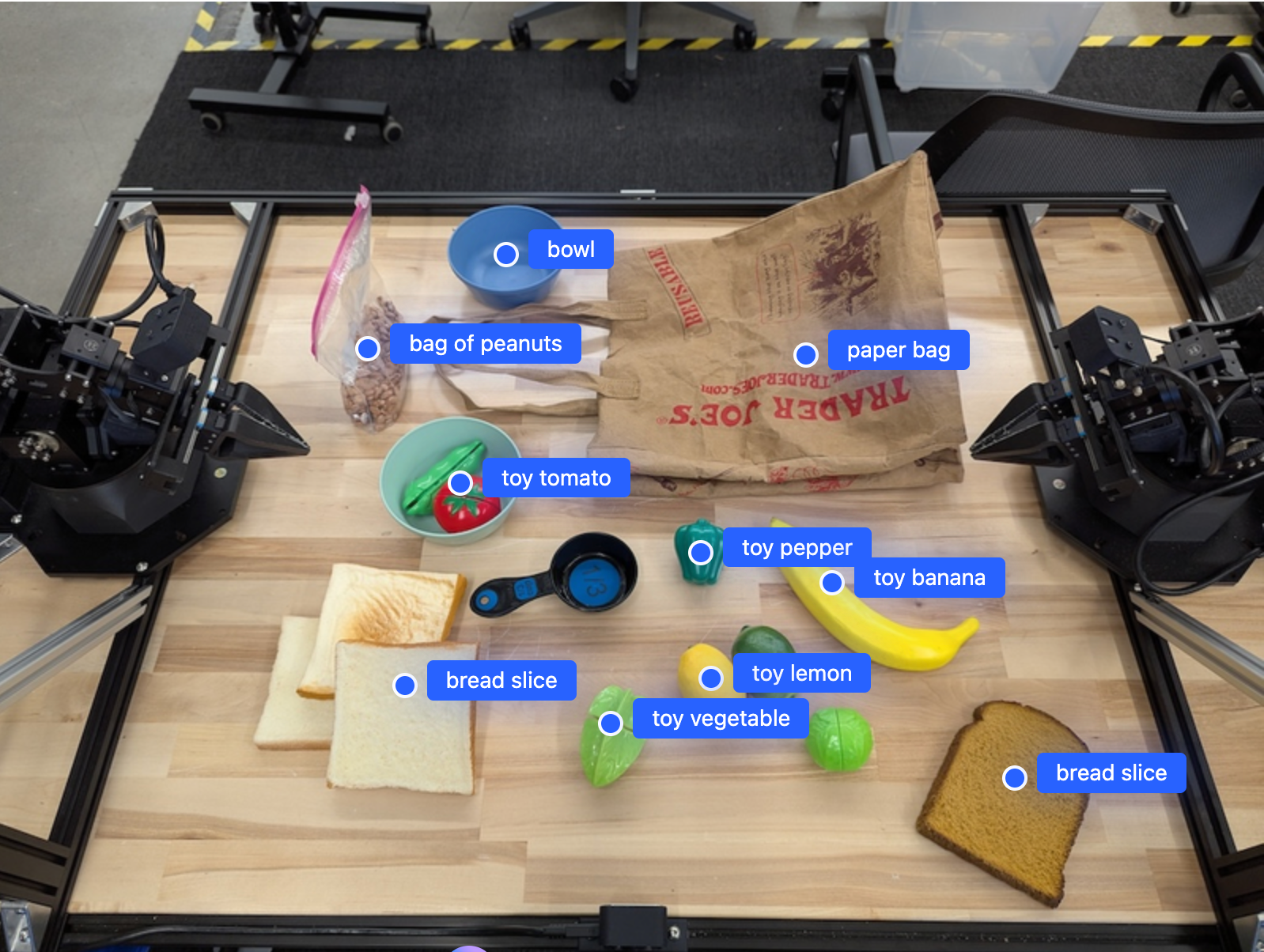
यह कैसे काम करता है
Gemini Robotics-ER 1.5 की मदद से, आपके रोबोट कॉन्टेक्स्ट के हिसाब से काम कर सकते हैं. साथ ही, वे स्पेस की जानकारी का इस्तेमाल करके, फ़िज़िकल दुनिया में काम कर सकते हैं. यह इमेज/वीडियो/ऑडियो इनपुट और नैचुरल लैंग्वेज प्रॉम्प्ट लेता है, ताकि:
- ऑब्जेक्ट और सीन के कॉन्टेक्स्ट को समझना: यह ऑब्जेक्ट की पहचान करता है और सीन के साथ उनके संबंध के बारे में बताता है. इसमें यह भी शामिल है कि ऑब्जेक्ट का इस्तेमाल कैसे किया जा सकता है.
- टास्क के निर्देशों को समझना: बोलचाल की भाषा में दिए गए टास्क को समझना, जैसे कि "केला ढूंढो".
- स्पेशल और टेम्परल रीज़निंग: कार्रवाइयों के क्रम और समय के साथ किसी सीन में ऑब्जेक्ट किस तरह इंटरैक्ट करते हैं, यह समझना.
- स्ट्रक्चर्ड आउटपुट उपलब्ध कराएं: इससे ऑब्जेक्ट की जगहों को दिखाने वाले निर्देशांक (पॉइंट या बाउंडिंग बॉक्स) मिलते हैं.
इससे रोबोट, प्रोग्राम के हिसाब से अपने आस-पास के माहौल को "देख" और "समझ" पाते हैं.
Gemini Robotics-ER 1.5 में एजेंटिक क्षमता भी है. इसका मतलब है कि यह मुश्किल टास्क (जैसे, "सेब को कटोरे में रखो") को छोटे-छोटे टास्क में बांट सकता है, ताकि लंबे समय तक चलने वाले टास्क को पूरा किया जा सके:
- उपटास्क को क्रम से लगाना: यह कमांड को चरणों के लॉजिकल सीक्वेंस में बांटता है.
- फ़ंक्शन कॉल/कोड को लागू करना: यह सुविधा, आपके मौजूदा रोबोट फ़ंक्शन/टूल को कॉल करके या जनरेट किए गए कोड को लागू करके चरणों को पूरा करती है.
फ़ंक्शन कॉलिंग पेज पर जाकर, इस बारे में ज़्यादा जानें कि Gemini के साथ फ़ंक्शन कॉलिंग की सुविधा कैसे काम करती है.
Gemini Robotics-ER 1.5 के साथ थिंकिंग बजट का इस्तेमाल करना
Gemini Robotics-ER 1.5 में, थिंकिंग बजट की सुविधा उपलब्ध है. इससे आपको यह तय करने में मदद मिलती है कि जवाब देने में कितना समय लगेगा और जवाब कितना सटीक होगा. स्पेशल अंडरस्टैंडिंग वाले टास्क, जैसे कि ऑब्जेक्ट का पता लगाना, मॉडल कम थिंकिंग बजट के साथ अच्छी परफ़ॉर्मेंस दे सकता है. गिनती करने और वज़न का अनुमान लगाने जैसे मुश्किल कामों के लिए, ज़्यादा थिंकिंग बजट फ़ायदेमंद होता है. इससे आपको ज़्यादा मुश्किल टास्क के लिए, कम समय में मिलने वाले जवाबों और ज़्यादा सटीक नतीजों के बीच संतुलन बनाने में मदद मिलती है.
थिंकिंग बजट के बारे में ज़्यादा जानने के लिए, थिंकिंग की मुख्य क्षमताओं वाला पेज देखें.
रोबोटिक्स के लिए एजेंटिक एआई की सुविधाएं
इस सेक्शन में, Gemini Robotics-ER 1.5 की अलग-अलग क्षमताओं के बारे में बताया गया है. इसमें यह भी दिखाया गया है कि रोबोटिक परसेप्शन, तर्क, और प्लानिंग ऐप्लिकेशन के लिए इस मॉडल का इस्तेमाल कैसे किया जाता है.
इस सेक्शन में दिए गए उदाहरणों से, इमेज में मौजूद ऑब्जेक्ट को पॉइंट करने और ढूंढने से लेकर, ट्रैजेक्ट्री की योजना बनाने और लंबे समय तक चलने वाले टास्क को व्यवस्थित करने तक की क्षमताओं के बारे में पता चलता है. आसानी से समझने के लिए, कोड स्निपेट को छोटा कर दिया गया है, ताकि प्रॉम्प्ट और generate_content एपीआई को कॉल करने का तरीका दिखाया जा सके. पूरा कोड और अन्य उदाहरण, रोबोटिक्स कुकबुक में देखे जा सकते हैं.
ऑब्जेक्ट की ओर इशारा करना
रोबोटिक्स में, विज़न-एंड-लैंग्वेज मॉडल (वीएलएम) का इस्तेमाल आम तौर पर इमेज या वीडियो फ़्रेम में मौजूद चीज़ों को ढूंढने और उनकी ओर इशारा करने के लिए किया जाता है. यहां दिए गए उदाहरण में, मॉडल से किसी इमेज में मौजूद खास ऑब्जेक्ट ढूंढने और उनके कोऑर्डिनेट को इमेज में दिखाने के लिए कहा गया है.
Python
from google import genai
from google.genai import types
client = genai.Client()
# Load your image and set up your prompt
with open('path/to/image-with-objects.jpg', 'rb') as f:
image_bytes = f.read()
queries = [
"bread",
"starfruit",
"banana",
]
prompt = f"""
Get all points matching the following objects: {', '.join(queries)}. The
label returned should be an identifying name for the object detected.
The answer should follow the json format:
[{{"point": , "label": }}, ...]. The points are in
[y, x] format normalized to 0-1000.
"""
image_response = client.models.generate_content(
model="gemini-robotics-er-1.5-preview",
contents=[
types.Part.from_bytes(
data=image_bytes,
mime_type='image/jpeg',
),
prompt
],
config = types.GenerateContentConfig(
temperature=0.5,
thinking_config=types.ThinkingConfig(thinking_budget=0)
)
)
print(image_response.text)
आउटपुट, 'शुरू करें' सेक्शन में दिए गए उदाहरण की तरह होगा. यह एक JSON होगा, जिसमें ऑब्जेक्ट के कोऑर्डिनेट और उनके लेबल शामिल होंगे.
[
{"point": [671, 317], "label": "bread"},
{"point": [738, 307], "label": "bread"},
{"point": [702, 237], "label": "bread"},
{"point": [629, 307], "label": "bread"},
{"point": [833, 800], "label": "bread"},
{"point": [609, 663], "label": "banana"},
{"point": [770, 483], "label": "starfruit"}
]
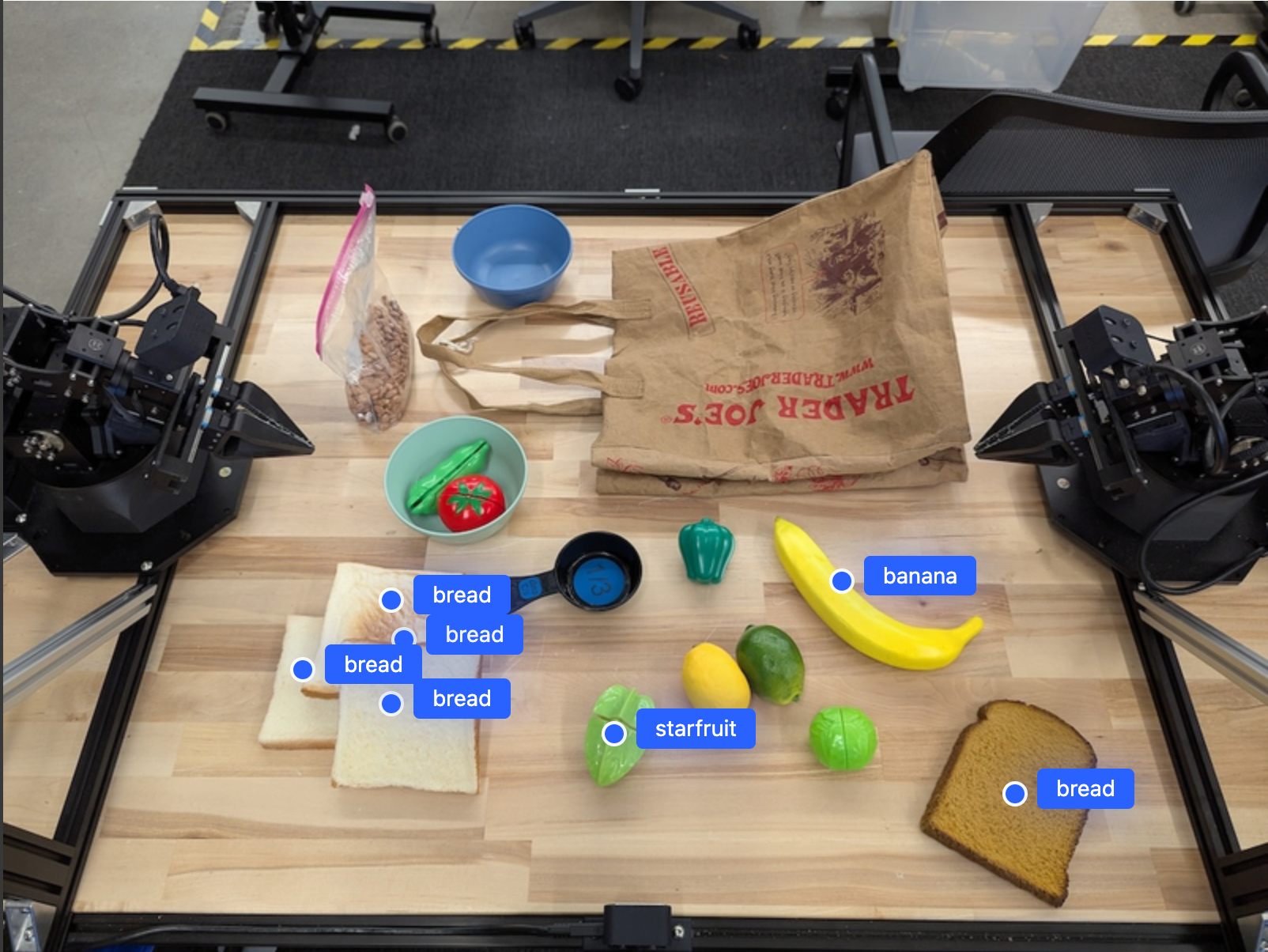
मॉडल से, किसी इमेज में मौजूद सभी चीज़ों की पहचान करने और उन्हें "फल" जैसी सामान्य कैटगरी में रखने का अनुरोध करने के लिए, यहां दिया गया प्रॉम्प्ट इस्तेमाल करें.
Python
prompt = f"""
Get all points for fruit. The label returned should be an identifying
name for the object detected.
""" + """The answer should follow the json format:
[{"point": <point>, "label": <label1>}, ...]. The points are in
[y, x] format normalized to 0-1000."""
इमेज को प्रोसेस करने की अन्य तकनीकों के बारे में जानने के लिए, इमेज को समझना पेज पर जाएं.
वीडियो में ऑब्जेक्ट ट्रैक करना
Gemini Robotics-ER 1.5, वीडियो फ़्रेम का विश्लेषण करके, समय के साथ-साथ ऑब्जेक्ट को ट्रैक भी कर सकता है. काम करने वाले वीडियो फ़ॉर्मैट की सूची देखने के लिए, वीडियो इनपुट देखें.
मॉडल जिस फ़्रेम का विश्लेषण करता है उसमें मौजूद खास ऑब्जेक्ट को खोजने के लिए, इस प्रॉम्प्ट का इस्तेमाल किया जाता है:
Python
# Define the objects to find
queries = [
"pen (on desk)",
"pen (in robot hand)",
"laptop (opened)",
"laptop (closed)",
]
base_prompt = f"""
Point to the following objects in the provided image: {', '.join(queries)}.
The answer should follow the json format:
[{{"point": , "label": }}, ...].
The points are in [y, x] format normalized to 0-1000.
If no objects are found, return an empty JSON list [].
"""
इस इमेज में, वीडियो के सभी फ़्रेम में पेन और लैपटॉप को ट्रैक किया गया है.
![]()
पूरे रन करने लायक कोड के लिए, रोबोटिक्स कुकबुक देखें.
ऑब्जेक्ट का पता लगाना और बाउंडिंग बॉक्स
मॉडल, सिंगल पॉइंट के अलावा 2D बाउंडिंग बॉक्स भी दिखा सकता है. इससे किसी ऑब्जेक्ट के चारों ओर आयताकार क्षेत्र दिखता है.
इस उदाहरण में, टेबल पर मौजूद पहचाने जा सकने वाले ऑब्जेक्ट के लिए 2D बाउंडिंग बॉक्स का अनुरोध किया गया है. मॉडल को यह निर्देश दिया गया है कि वह आउटपुट में ज़्यादा से ज़्यादा 25 ऑब्जेक्ट शामिल करे. साथ ही, एक से ज़्यादा इंस्टेंस को यूनीक नाम दे.
Python
from google import genai
from google.genai import types
client = genai.Client()
# Load your image and set up your prompt
with open('path/to/image-with-objects.jpg', 'rb') as f:
image_bytes = f.read()
prompt = """
Return bounding boxes as a JSON array with labels. Never return masks
or code fencing. Limit to 25 objects. Include as many objects as you
can identify on the table.
If an object is present multiple times, name them according to their
unique characteristic (colors, size, position, unique characteristics, etc..).
The format should be as follows: [{"box_2d": [ymin, xmin, ymax, xmax],
"label": <label for the object>}] normalized to 0-1000. The values in
box_2d must only be integers
"""
image_response = client.models.generate_content(
model="gemini-robotics-er-1.5-preview",
contents=[
types.Part.from_bytes(
data=image_bytes,
mime_type='image/jpeg',
),
prompt
],
config = types.GenerateContentConfig(
temperature=0.5,
thinking_config=types.ThinkingConfig(thinking_budget=0)
)
)
print(image_response.text)
यहां मॉडल से मिले बॉक्स दिखाए गए हैं.
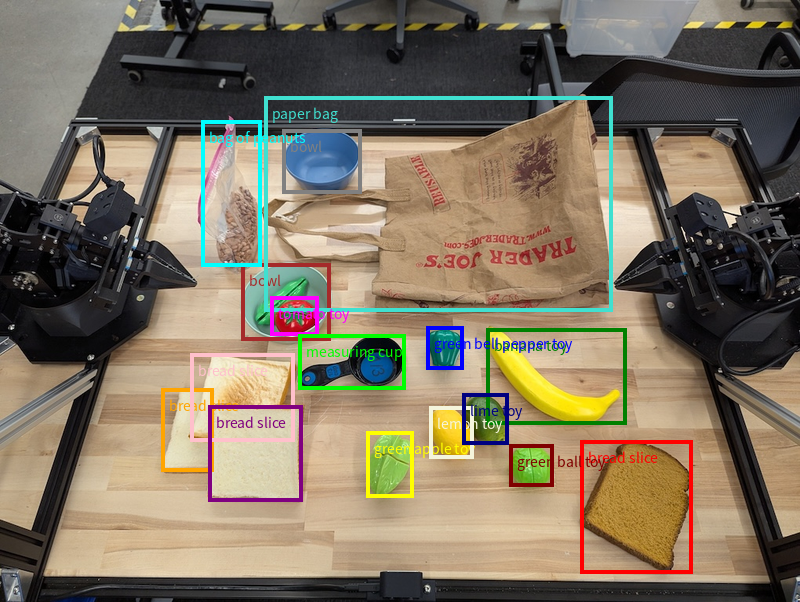
पूरा कोड देखने के लिए, Robotics cookbook देखें. इमेज को समझना पेज पर, सेगमेंटेशन और ऑब्जेक्ट डिटेक्शन जैसे विज़ुअल टास्क के अन्य उदाहरण भी दिए गए हैं.
बाउंडिंग बॉक्स के अन्य उदाहरण, इमेज को समझना पेज पर देखे जा सकते हैं.
ट्रैजेक्ट्री
Gemini Robotics-ER 1.5, ऐसे पॉइंट के सीक्वेंस जनरेट कर सकता है जो किसी ट्रैजेक्ट्री को तय करते हैं. ये पॉइंट, रोबोट के मूवमेंट को गाइड करने के लिए फ़ायदेमंद होते हैं.
इस उदाहरण में, लाल पेन को ऑर्गनाइज़र तक ले जाने के लिए, ट्रैजेक्ट्री का अनुरोध किया गया है. इसमें शुरुआती पॉइंट और इंटरमीडिएट पॉइंट की सीरीज़ शामिल है.
Python
from google import genai
from google.genai import types
client = genai.Client()
# Load your image and set up your prompt
with open('path/to/image-with-objects.jpg', 'rb') as f:
image_bytes = f.read()
points_data = []
prompt = """
Place a point on the red pen, then 15 points for the trajectory of
moving the red pen to the top of the organizer on the left.
The points should be labeled by order of the trajectory, from '0'
(start point at left hand) to <n> (final point)
The answer should follow the json format:
[{"point": <point>, "label": <label1>}, ...].
The points are in [y, x] format normalized to 0-1000.
"""
image_response = client.models.generate_content(
model="gemini-robotics-er-1.5-preview",
contents=[
types.Part.from_bytes(
data=image_bytes,
mime_type='image/jpeg',
),
prompt
],
config = types.GenerateContentConfig(
temperature=0.5,
)
)
print(image_response.text)
जवाब में, कोऑर्डिनेट का एक सेट दिया गया है. इसमें उस पाथ की जानकारी दी गई है जिस पर लाल पेन को चलना चाहिए, ताकि उसे ऑर्गेनाइज़र के ऊपर ले जाने का टास्क पूरा किया जा सके:
[
{"point": [550, 610], "label": "0"},
{"point": [500, 600], "label": "1"},
{"point": [450, 590], "label": "2"},
{"point": [400, 580], "label": "3"},
{"point": [350, 550], "label": "4"},
{"point": [300, 520], "label": "5"},
{"point": [250, 490], "label": "6"},
{"point": [200, 460], "label": "7"},
{"point": [180, 430], "label": "8"},
{"point": [160, 400], "label": "9"},
{"point": [140, 370], "label": "10"},
{"point": [120, 340], "label": "11"},
{"point": [110, 320], "label": "12"},
{"point": [105, 310], "label": "13"},
{"point": [100, 305], "label": "14"},
{"point": [100, 300], "label": "15"}
]
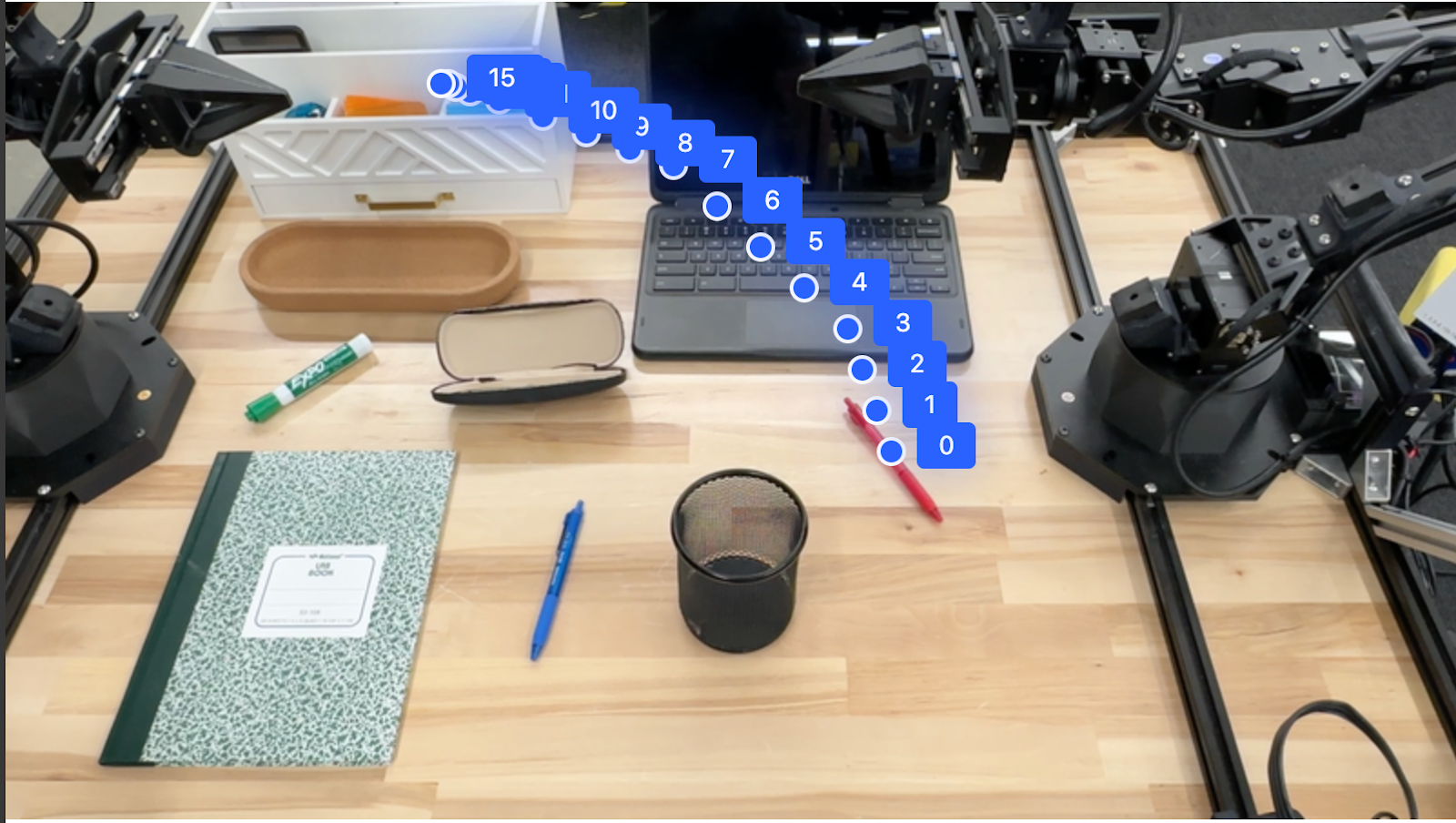
आयोजन सेवाएं
Gemini Robotics-ER 1.5, स्पेस के बारे में ज़्यादा बेहतर तरीके से सोच-विचार कर सकता है. साथ ही, कॉन्टेक्स्ट को समझकर कार्रवाइयां कर सकता है या सबसे सही जगहों की पहचान कर सकता है.
लैपटॉप रखने के लिए जगह बनाना
इस उदाहरण में दिखाया गया है कि Gemini Robotics-ER, किसी जगह के बारे में कैसे तर्क दे सकता है. इस प्रॉम्प्ट में, मॉडल से यह पता लगाने के लिए कहा गया है कि किस ऑब्जेक्ट को हटाकर, किसी दूसरे आइटम के लिए जगह बनानी है.
Python
from google import genai
from google.genai import types
client = genai.Client()
# Load your image and set up your prompt
with open('path/to/image-with-objects.jpg', 'rb') as f:
image_bytes = f.read()
prompt = """
Point to the object that I need to remove to make room for my laptop
The answer should follow the json format: [{"point": <point>,
"label": <label1>}, ...]. The points are in [y, x] format normalized to 0-1000.
"""
image_response = client.models.generate_content(
model="gemini-robotics-er-1.5-preview",
contents=[
types.Part.from_bytes(
data=image_bytes,
mime_type='image/jpeg',
),
prompt
],
config = types.GenerateContentConfig(
temperature=0.5,
thinking_config=types.ThinkingConfig(thinking_budget=0)
)
)
print(image_response.text)
जवाब में, उस ऑब्जेक्ट का 2D कोऑर्डिनेट होता है जो उपयोगकर्ता के सवाल का जवाब देता है. इस मामले में, वह ऑब्जेक्ट जो लैपटॉप रखने के लिए जगह बनाने के लिए हिलना चाहिए.
[
{"point": [672, 301], "label": "The object that I need to remove to make room for my laptop"}
]
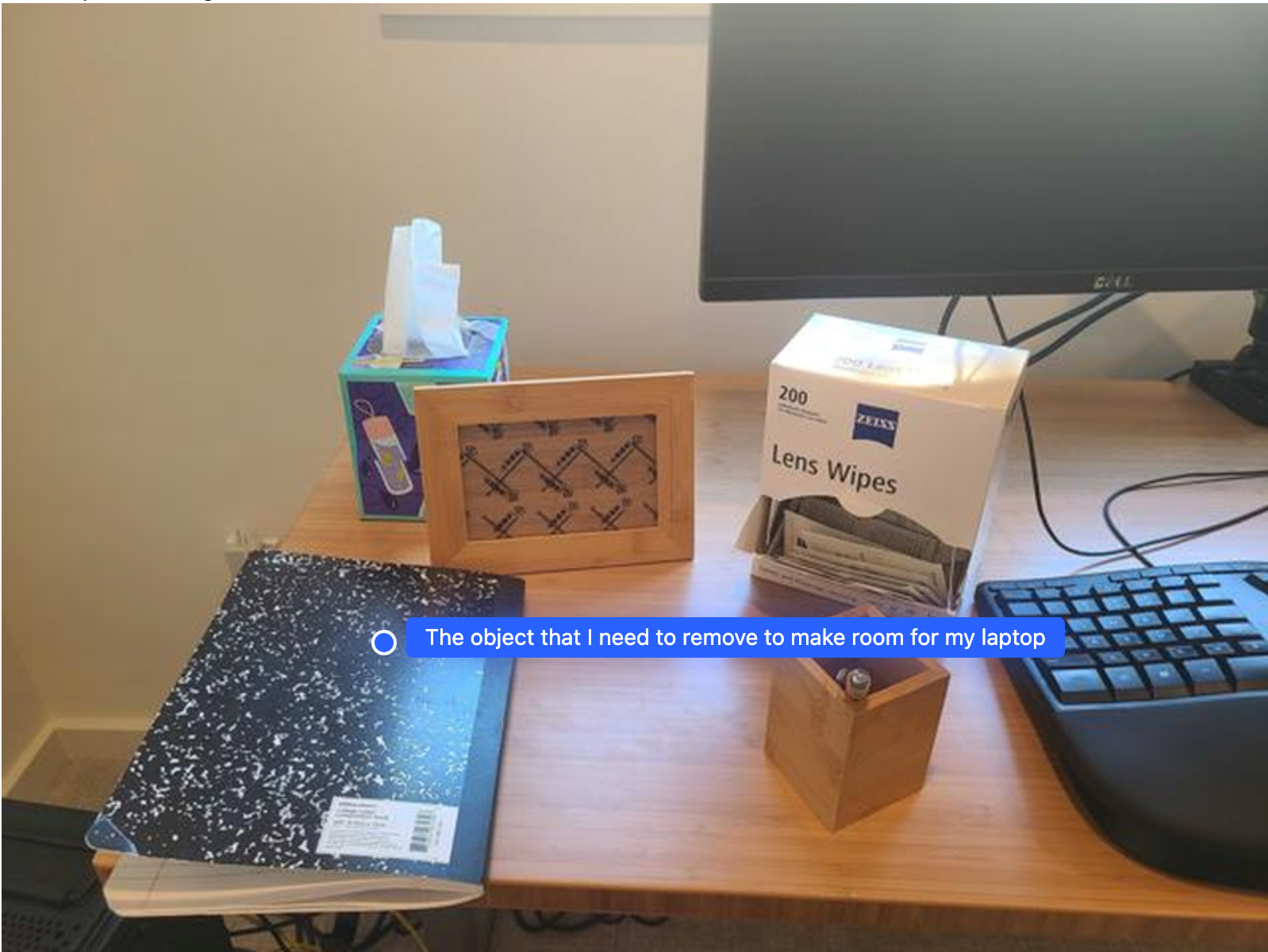
लंच पैक करना
यह मॉडल, एक से ज़्यादा चरणों वाले टास्क के लिए निर्देश भी दे सकता है. साथ ही, हर चरण के लिए काम की चीज़ों की ओर इशारा कर सकता है. इस उदाहरण में दिखाया गया है कि मॉडल, लंच बैग पैक करने के लिए कई चरणों की योजना कैसे बनाता है.
Python
from google import genai
from google.genai import types
client = genai.Client()
# Load your image and set up your prompt
with open('path/to/image-of-lunch.jpg', 'rb') as f:
image_bytes = f.read()
prompt = """
Explain how to pack the lunch box and lunch bag. Point to each
object that you refer to. Each point should be in the format:
[{"point": [y, x], "label": }], where the coordinates are
normalized between 0-1000.
"""
image_response = client.models.generate_content(
model="gemini-robotics-er-1.5-preview",
contents=[
types.Part.from_bytes(
data=image_bytes,
mime_type='image/jpeg',
),
prompt
],
config = types.GenerateContentConfig(
temperature=0.5,
thinking_config=types.ThinkingConfig(thinking_budget=0)
)
)
print(image_response.text)
इस प्रॉम्प्ट के जवाब में, इमेज इनपुट से लंच बैग पैक करने के बारे में सिलसिलेवार निर्देश दिए गए हैं.
इनपुट इमेज
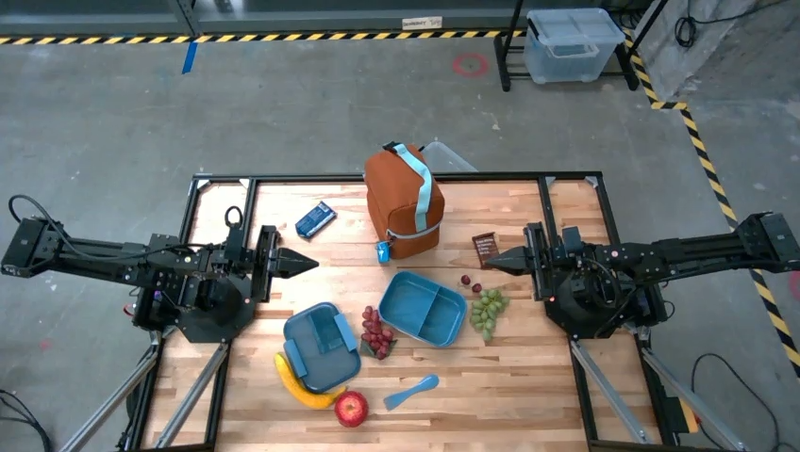
मॉडल का आउटपुट
Based on the image, here is a plan to pack the lunch box and lunch bag:
1. **Pack the fruit into the lunch box.** Place the [apple](apple), [banana](banana), [red grapes](red grapes), and [green grapes](green grapes) into the [blue lunch box](blue lunch box).
2. **Add the spoon to the lunch box.** Put the [blue spoon](blue spoon) inside the lunch box as well.
3. **Close the lunch box.** Secure the lid on the [blue lunch box](blue lunch box).
4. **Place the lunch box inside the lunch bag.** Put the closed [blue lunch box](blue lunch box) into the [brown lunch bag](brown lunch bag).
5. **Pack the remaining items into the lunch bag.** Place the [blue snack bar](blue snack bar) and the [brown snack bar](brown snack bar) into the [brown lunch bag](brown lunch bag).
Here is the list of objects and their locations:
* [{"point": [899, 440], "label": "apple"}]
* [{"point": [814, 363], "label": "banana"}]
* [{"point": [727, 470], "label": "red grapes"}]
* [{"point": [675, 608], "label": "green grapes"}]
* [{"point": [706, 529], "label": "blue lunch box"}]
* [{"point": [864, 517], "label": "blue spoon"}]
* [{"point": [499, 401], "label": "blue snack bar"}]
* [{"point": [614, 705], "label": "brown snack bar"}]
* [{"point": [448, 501], "label": "brown lunch bag"}]
कस्टम रोबोट एपीआई को कॉल करना
इस उदाहरण में, कस्टम रोबोट एपीआई की मदद से टास्क ऑर्केस्ट्रेशन के बारे में बताया गया है. इसमें पिक-एंड-प्लेस ऑपरेशन के लिए डिज़ाइन किया गया मॉक एपीआई शामिल है. टास्क में, नीले रंग के ब्लॉक को उठाकर नारंगी रंग के कटोरे में रखना है:
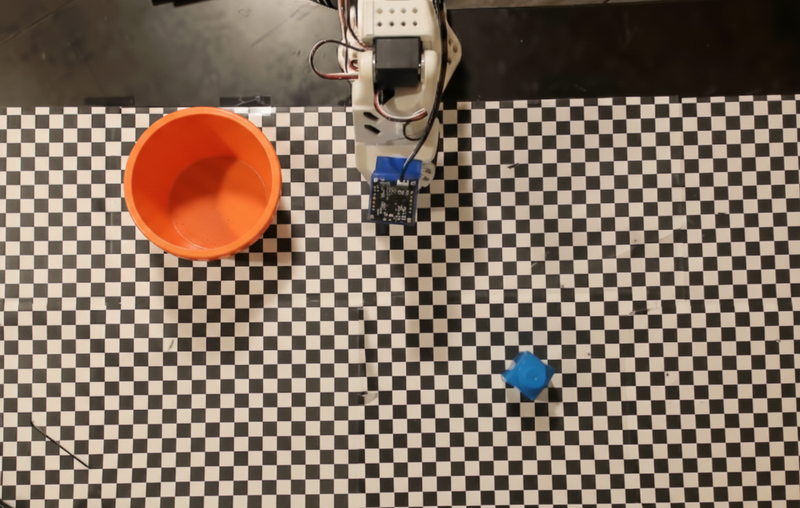
इस पेज पर दिए गए अन्य उदाहरणों की तरह, पूरा कोड Robotics cookbook में उपलब्ध है.
सबसे पहले, इन दोनों आइटम का पता लगाएं. इसके लिए, यह प्रॉम्प्ट इस्तेमाल करें:
Python
prompt = """
Locate and point to the blue block and the orange bowl. The label
returned should be an identifying name for the object detected.
The answer should follow the json format: [{"point": <point>, "label": <label1>}, ...].
The points are in [y, x] format normalized to 0-1000.
"""
मॉडल के जवाब में, ब्लॉक और कटोरे के सामान्य किए गए कोऑर्डिनेट शामिल हैं:
[
{"point": [389, 252], "label": "orange bowl"},
{"point": [727, 659], "label": "blue block"}
]
इस उदाहरण में, मॉक रोबोट एपीआई का इस्तेमाल किया गया है:
Python
def move(x, y, high):
print(f"moving to coordinates: {x}, {y}, {15 if high else 5}")
def setGripperState(opened):
print("Opening gripper" if opened else "Closing gripper")
def returnToOrigin():
print("Returning to origin pose")
अगला चरण, कार्रवाई को पूरा करने के लिए ज़रूरी लॉजिक के साथ एपीआई फ़ंक्शन के क्रम को कॉल करना है. इस प्रॉम्प्ट में, रोबोट एपीआई के बारे में जानकारी दी गई है. मॉडल को इस टास्क को पूरा करने के लिए, इस एपीआई का इस्तेमाल करना चाहिए.
Python
prompt = f"""
You are a robotic arm with six degrees-of-freedom. You have the
following functions available to you:
def move(x, y, high):
# moves the arm to the given coordinates. The boolean value 'high' set
to True means the robot arm should be lifted above the scene for
avoiding obstacles during motion. 'high' set to False means the robot
arm should have the gripper placed on the surface for interacting with
objects.
def setGripperState(opened):
# Opens the gripper if opened set to true, otherwise closes the gripper
def returnToOrigin():
# Returns the robot to an initial state. Should be called as a cleanup
operation.
The origin point for calculating the moves is at normalized point
y={robot_origin_y}, x={robot_origin_x}. Use this as the new (0,0) for
calculating moves, allowing x and y to be negative.
Perform a pick and place operation where you pick up the blue block at
normalized coordinates ({block_x}, {block_y}) (relative coordinates:
{block_relative_x}, {block_relative_y}) and place it into the orange
bowl at normalized coordinates ({bowl_x}, {bowl_y})
(relative coordinates: {bowl_relative_x}, {bowl_relative_y}).
Provide the sequence of function calls as a JSON list of objects, where
each object has a "function" key (the function name) and an "args" key
(a list of arguments for the function).
Also, include your reasoning before the JSON output.
For example:
Reasoning: To pick up the block, I will first move the arm to a high
position above the block, open the gripper, move down to the block,
close the gripper, lift the arm, move to a high position above the bowl,
move down to the bowl, open the gripper, and then lift the arm back to
a high position.
"""
यहां प्रॉम्प्ट और मॉक रोबोट एपीआई के आधार पर, मॉडल से मिलने वाला संभावित आउटपुट दिखाया गया है. आउटपुट में, मॉडल की सोचने की प्रोसेस और उन टास्क के बारे में जानकारी शामिल होती है जिन्हें मॉडल ने प्लान किया है. इसमें, रोबोट के फ़ंक्शन कॉल का आउटपुट भी दिखता है. मॉडल ने इन फ़ंक्शन कॉल को एक साथ क्रम से लगाया है.
Reasoning: To perform the pick and place operation, I will first move the
robotic arm to a high position above the blue block to ensure clearance. Then, I
will open the gripper in preparation for grasping. Next, I will lower the arm to
the surface level to position the gripper around the block and close the gripper
to secure it. After picking up the block, I will lift the arm to clear the
surface and move towards the orange bowl, maintaining a high position to avoid
collisions. Once positioned above the bowl, I will lower the arm to place the
block inside. I will then open the gripper to release the block. Finally, I will
lift the arm out of the bowl and call `returnToOrigin` to reset the robot's
state.
[
{
"function": "move",
"args": [
163,
427,
true
]
},
{
"function": "setGripperState",
"args": [
true
]
},
{
"function": "move",
"args": [
163,
427,
false
]
},
{
"function": "setGripperState",
"args": [
false
]
},
{
"function": "move",
"args": [
163,
427,
true
]
},
{
"function": "move",
"args": [
-247,
90,
true
]
},
{
"function": "move",
"args": [
-247,
90,
false
]
},
{
"function": "setGripperState",
"args": [
true
]
},
{
"function": "move",
"args": [
-247,
90,
true
]
},
{
"function": "returnToOrigin",
"args": []
}
]
Executing Function Calls:
moving to coordinates: 163, 427, 15
Opening gripper
moving to coordinates: 163, 427, 5
Closing gripper
moving to coordinates: 163, 427, 15
moving to coordinates: -247, 90, 15
moving to coordinates: -247, 90, 5
Opening gripper
moving to coordinates: -247, 90, 15
Returning to origin pose
कोड को चलाना
Gemini Robotics-ER 1.5, ऐसे टास्क पूरे करने के लिए Python कोड का सुझाव दे सकता है और उसे लागू कर सकता है जिनमें डाइनैमिक ऐक्शन की ज़रूरत होती है. जैसे, किसी इमेज के हिस्से को ज़ूम करके ज़्यादा जानकारी देखना.
इस उदाहरण में दिखाया गया है कि मॉडल, इमेज के किसी खास हिस्से को "ज़ूम इन" करने के लिए, कोड एक्ज़ीक्यूशन टूल का इस्तेमाल करने का सुझाव कैसे दे सकता है. इसके बाद, वह उपयोगकर्ता के सवाल का जवाब देने के लिए, इस टूल का इस्तेमाल करता है.
Python
from google import genai
from google.genai import types
client = genai.Client()
# Load your image and set up your prompt
with open('path/to/image-of-object.jpg', 'rb') as f:
image_bytes = f.read()
prompt = """
What is the air quality reading? Using the code execution feature,
zoom in on the image to take a closer look.
"""
response = client.models.generate_content(
model="gemini-robotics-er-1.5-preview",
contents=[
types.Part.from_bytes(
data=image_bytes,
mime_type='image/jpeg',
),
prompt
],
config = types.GenerateContentConfig(
temperature=0.5,
tools=[types.Tool(code_execution=types.ToolCodeExecution)]
)
)
for part in response.candidates[0].content.parts:
if part.text is not None:
print(part.text)
if part.executable_code is not None:
print(part.executable_code.code)
if part.code_execution_result is not None:
print(part.code_execution_result.output)
इस टास्क के लिए, मॉडल से मिले जवाब का एक उदाहरण यहां दिया गया है. आउटपुट में, स्क्रीन को बेहतर तरीके से पढ़ने के लिए इमेज को ज़ूम करने का कोड जनरेट करने वाला मॉडल दिखाया गया है. इसमें यह भी बताया जाता है कि इमेज को काट-छांट करने के लिए, किन बातों का ध्यान रखा गया. पूरे सैंपल आउटपुट के लिए, रोबोटिक्स कुकबुक देखें.
# Detect relevant objects and output in json format
# [{"box_2d": [379, 407, 481, 553], "label": "display"}]
from PIL import Image
# Open the image
img = Image.open("input_file_0.jpeg")
# Define the coordinates for cropping (normalized to 0-1000)
# Based on visual inspection, the display is roughly centered around [430, 430] to [500, 500] in a 1000x1000 scale.
# Let's try to zoom in on the display area.
# Bounding box for display: [ymin, xmin, ymax, xmax] in pixels.
# From visual inspection of the original image (size 90489 bytes, resolution
unknown but let's assume a standard aspect ratio and roughly 1000x1000 for
relative positioning),
# the display is located at approximately y=380-480, x=410-540.
# Let's define a larger area around it for context.
# Let's say we want to crop from y=350 to y=550 and x=350 to x=650.
...
thought
The crop was too tight and only captured part of the display. Let's adjust the bounding box.
The previous crop was `img.crop((400, 350, 600, 500))`. This means xmin=400, ymin=350, xmax=600, ymax=500.
The display is centered around x=480, y=430.
The previous crop captured the left side of the display.
Let's expand the x range to the right and y range to cover the whole circle.
New bounding box estimate: ymin=370, xmin=400, ymax=500, xmax=600.
Let's try again with a wider crop.
# Detect relevant objects and output in json format
# [{"box_2d": [379, 407, 481, 553], "label": "display"}]
from PIL import Image
# Open the image
img = Image.open("input_file_0.jpeg")
# Define the coordinates for cropping (normalized to 0-1000)
…
The reading of 14 falls into the "Moderate" category.
The prompt asks for the "air quality reading", which can be interpreted as
either the numerical value or the categorical description. Given the numerical
value is explicitly displayed, it's the primary reading.
Let's provide the numerical value as the reading.
The reading is 014.
Based on the display on the air purifier, the air quality reading is **014**.
सबसे सही तरीके
अपने रोबोटिक्स ऐप्लिकेशन की परफ़ॉर्मेंस और सटीकता को ऑप्टिमाइज़ करने के लिए, Gemini मॉडल के साथ असरदार तरीके से इंटरैक्ट करने का तरीका समझना ज़रूरी है. इस सेक्शन में, प्रॉम्प्ट बनाने, विज़ुअल डेटा को मैनेज करने, और टास्क को स्ट्रक्चर करने के सबसे सही तरीकों और अहम रणनीतियों के बारे में बताया गया है, ताकि सबसे भरोसेमंद नतीजे मिल सकें.
आसान और समझ में आने वाली भाषा का इस्तेमाल करें.
नैचुरल लैंग्वेज का इस्तेमाल करें: Gemini मॉडल को नैचुरल लैंग्वेज को समझने के लिए डिज़ाइन किया गया है. अपने प्रॉम्प्ट को इस तरह से स्ट्रक्चर करें कि वे सिमैंटिक तौर पर साफ़ हों और यह पता चले कि कोई व्यक्ति स्वाभाविक रूप से निर्देश कैसे देगा.
रोज़मर्रा के शब्दों का इस्तेमाल करें: तकनीकी या खास शब्दों के बजाय, आम बोलचाल की भाषा का इस्तेमाल करें. अगर मॉडल किसी शब्द का जवाब आपकी उम्मीद के मुताबिक नहीं दे रहा है, तो उस शब्द को किसी सामान्य शब्द से बदलें.
विज़ुअल इनपुट को ऑप्टिमाइज़ करें.
ज़्यादा जानकारी के लिए ज़ूम इन करें: जब छोटे ऑब्जेक्ट या वाइड शॉट में पहचान करने में मुश्किल होने वाले ऑब्जेक्ट के साथ काम किया जा रहा हो, तो बाउंडिंग बॉक्स फ़ंक्शन का इस्तेमाल करके, काम के ऑब्जेक्ट को अलग करें. इसके बाद, इमेज को इस सिलेक्शन के हिसाब से क्रॉप किया जा सकता है. साथ ही, ज़्यादा बारीकी से विश्लेषण करने के लिए, मॉडल को फ़ोकस की गई नई इमेज भेजी जा सकती है.
रोशनी और रंग के साथ एक्सपेरिमेंट करें: रोशनी की मुश्किल स्थितियों और खराब कलर कंट्रास्ट की वजह से, मॉडल की परफ़ॉर्मेंस पर असर पड़ सकता है.
मुश्किल समस्याओं को छोटे-छोटे चरणों में तोड़ें. हर छोटे चरण को अलग-अलग तरीके से हल करके, मॉडल को ज़्यादा सटीक और बेहतर नतीजे पाने में मदद की जा सकती है.
सहमति के आधार पर, जवाब को ज़्यादा सटीक बनाना. जिन टास्क के लिए सटीक जवाब की ज़रूरत होती है उनके लिए, एक ही प्रॉम्प्ट का इस्तेमाल करके मॉडल से कई बार क्वेरी की जा सकती है. जवाबों का औसत निकालकर, "सहमति" पर पहुंचा जा सकता है. यह अक्सर ज़्यादा सटीक और भरोसेमंद होती है.
सीमाएं
Gemini Robotics-ER 1.5 का इस्तेमाल करके डेवलपमेंट करते समय, इन सीमाओं का ध्यान रखें:
- झलक की स्थिति: मॉडल फ़िलहाल झलक में है. एपीआई और सुविधाओं में बदलाव हो सकता है. साथ ही, बिना पूरी तरह से जांच किए, प्रोडक्शन के लिए ज़रूरी ऐप्लिकेशन के लिए यह सही नहीं हो सकता.
- लेटेंसी: मुश्किल क्वेरी, हाई रिज़ॉल्यूशन वाले इनपुट या ज़्यादा
thinking_budgetकी वजह से, प्रोसेस होने में ज़्यादा समय लग सकता है. - गलत जानकारी: सभी लार्ज लैंग्वेज मॉडल की तरह, Gemini Robotics-ER 1.5 कभी-कभी "गलत जानकारी" दे सकता है. यह खास तौर पर, ऐसे प्रॉम्प्ट के लिए होता है जो साफ़ तौर पर नहीं बताए गए होते हैं या जिनके इनपुट, ट्रेनिंग डेटा से बाहर के होते हैं.
- प्रॉम्प्ट की क्वालिटी पर निर्भरता: मॉडल के आउटपुट की क्वालिटी, इनपुट प्रॉम्प्ट की स्पष्टता और खास जानकारी पर काफ़ी हद तक निर्भर करती है. अस्पष्ट या खराब तरीके से स्ट्रक्चर किए गए प्रॉम्प्ट से, सही नतीजे नहीं मिलते.
- कैलकुलेशन की लागत: मॉडल को चलाने में, खास तौर पर वीडियो इनपुट या ज़्यादा
thinking_budgetके साथ, कैलकुलेशन के संसाधनों का इस्तेमाल होता है और लागत लगती है. ज़्यादा जानकारी के लिए, सोचना पेज देखें. - इनपुट टाइप: हर मोड की सीमाओं के बारे में जानने के लिए, यहां दिए गए विषय देखें.
निजता सूचना
आप स्वीकार करते हैं कि इस दस्तावेज़ में बताए गए मॉडल ("रोबोटिक्स मॉडल") को चलाने और आपके निर्देशों के मुताबिक आपके हार्डवेयर को मूव करने के लिए, वीडियो और ऑडियो डेटा का इस्तेमाल किया जाता है. इसलिए, आपके पास रोबोटिक्स मॉडल को इस तरह से चलाने का विकल्प होता है कि रोबोटिक्स मॉडल, पहचान ज़ाहिर करने वाले लोगों का डेटा इकट्ठा कर सकें. जैसे, आवाज़, इमेज, और मिलते-जुलते डेटा ("निजी डेटा"). अगर आपको रोबोटिक मॉडल को इस तरह से इस्तेमाल करना है कि वह निजी डेटा इकट्ठा करे, तो आपको यह पक्का करना होगा कि किसी भी ऐसे व्यक्ति को रोबोटिक मॉडल के साथ इंटरैक्ट करने या उसके आस-पास मौजूद रहने की अनुमति न दी जाए जिसकी पहचान की जा सकती है. ऐसा तब तक करना होगा, जब तक ऐसे लोगों को यह सूचना न मिल जाए कि उनका निजी डेटा, Google को दिया जा सकता है और Google उसका इस्तेमाल कर सकता है. यह सूचना, Gemini API की सेवा की अतिरिक्त शर्तों के मुताबिक होनी चाहिए. ये शर्तें, https://ai.google.dev/gemini-api/terms पर उपलब्ध हैं. इन्हें "शर्तें" कहा जाता है. इनमें "Google आपके डेटा का इस्तेमाल कैसे करता है" सेक्शन में दी गई जानकारी भी शामिल है. आपको यह पक्का करना होगा कि इस तरह की सूचना में, शर्तों में बताए गए तरीके से निजी डेटा को इकट्ठा करने और इस्तेमाल करने की अनुमति दी गई हो. साथ ही, आपको व्यावसायिक तौर पर उचित प्रयास करने होंगे, ताकि निजी डेटा को कम से कम इकट्ठा किया जा सके और उसे कम से कम डिस्ट्रिब्यूट किया जा सके. इसके लिए, आपको चेहरे को धुंधला करने जैसी तकनीकों का इस्तेमाल करना होगा. साथ ही, रोबोटिक्स मॉडल को ऐसे इलाकों में चलाना होगा जहां लोगों की पहचान ज़ाहिर न हो.
कीमत
कीमत और उपलब्ध क्षेत्रों के बारे में ज़्यादा जानकारी के लिए, कीमत पेज पर जाएं.
मॉडल के वर्शन
| प्रॉपर्टी | ब्यौरा |
|---|---|
| मॉडल कोड | gemini-robotics-er-1.5-preview |
| इस्तेमाल किए जा सकने वाले डेटा टाइप |
इनपुट टेक्स्ट, इमेज, वीडियो, ऑडियो आउटपुट टेक्स्ट |
| टोकन की सीमाएं[*] |
इनपुट टोकन की सीमा 1,048,576 आउटपुट टोकन की सीमा 65,536 |
| मिलने वाली अनुमतियां |
ऑडियो जनरेट करने की सुविधा काम नहीं करता है Batch API काम नहीं करता है कैश मेमोरी में सेव होना काम नहीं करता है कोड को चलाने की सुविधा काम करता है फ़ंक्शन कॉलिंग काम करता है Google Maps की मदद से जवाब तैयार करना काम नहीं करता है इमेज जनरेट करना काम नहीं करता है Live API काम नहीं करता है भरोसेमंद स्रोतों से जानकारी लेना काम करता है स्ट्रक्चर्ड आउटपुट काम करता है सोचना काम करता है यूआरएल का कॉन्टेक्स्ट काम करता है |
| वर्शन |
|
| नया अपडेट | सितंबर 2025 |
| जानकारी न मिलना | जनवरी 2025 |
अगले चरण
- Gemini Robotics-ER 1.5 की अन्य क्षमताओं के बारे में जानें. साथ ही, अलग-अलग प्रॉम्प्ट और इनपुट का इस्तेमाल करके एक्सपेरिमेंट करना जारी रखें, ताकि आपको इसके और भी इस्तेमाल के बारे में पता चल सके. ज़्यादा उदाहरणों के लिए, रोबोटिक्स कुकबुक देखें.
- जानें कि Gemini Robotics मॉडल को सुरक्षा को ध्यान में रखकर कैसे बनाया गया है. इसके लिए, Google DeepMind के रोबोटिक्स की सुरक्षा से जुड़े पेज पर जाएं.
- Gemini Robotics के लैंडिंग पेज पर जाकर, Gemini Robotics के मॉडल से जुड़े नए अपडेट के बारे में पढ़ें.

